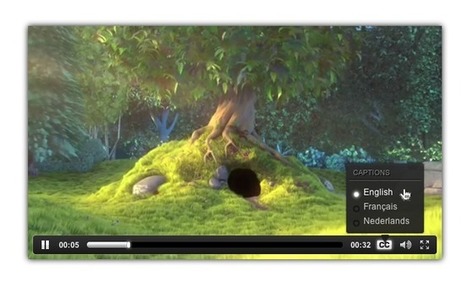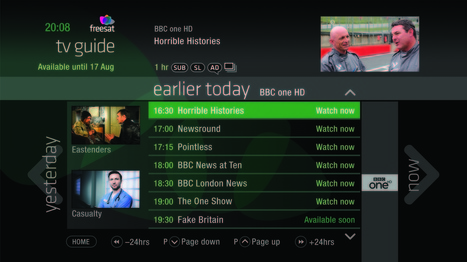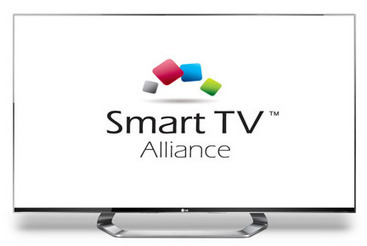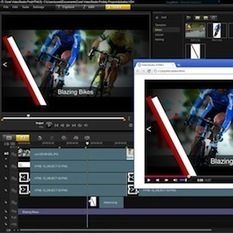 Your new post is loading...
 Your new post is loading...
Google has quietly started to switch some aspects of its premium content offerings to its open source WebM video format. Google’s WebM product manager John Lutherexplained during a developer Hangout Wednesday that YouTube and Google Play video rentals are now using WebM as opposed to Flash on Samsung’s Chromebooks. “We will be rolling that out on more Chrome OS devices and other platforms soon,” he added. Luther went on to explain that Google did a lot of work on the security layer that delivers the videos encrypted to an HTML5 player. “As far as I know, we are the first to ever do that,” he said.
A few days ago, a new proposal was put forward in the HTML Working Group (HTML WG) by Microsoft, Netflix, and Google to take DRM in HTML5 to the next stage of standardization at W3C. This triggered another uproar about the morality and ethics behind DRM and building it into the Web. There are good arguments about morality/ethics on both sides of the debate but ultimately, the HTML WG will decide whether or not to pursue the specification based on technical merit. I am a member of the HTML WG. I was also the founder of a start-up that focused on building a legal, peer-to-peer, content distribution network for music and movies. It employed DRM much like the current DRM in HTML5 proposal. During the course of 8 years of technical development, we had talks with many of the major record labels. I have first-hand knowledge of the problem, and building a technical solution to address the problem. The Encrypted Media Extensions (DRM in HTML5) specification does not solve the problem the authors are attempting to solve, which is the protection of content from opportunistic or professional piracy. The HTML WG should not publish First Public Working Drafts that do not effectively address the primary goal of a specification.
There are HTML5 apps and games that rival and even outperform native applications. The biggest brands such as Google, YouTube, LinkedIn and OpenTable (among others) are championing HTML5 — and delivering the goods. The only thing holding back HTML5 from killing native apps is DRM. Let’s be honest, production studios are in business to make money from the content they produce. Right now, native apps provide the protections studios require, but the ironic thing is that every video delivered through native apps is not Flash-based. Publishers have already done the heavy lifting for HTML5 delivery. They want to deliver videos in a mobile app that works across all devices — phone, tablet, laptop, and connected TVs. They want to build once, deliver everywhere. Publishers will then be able to get out of the dev shop business, and premium content will flourish online. HTML5 DRM enables this to happen — opening the floodgates.
The appeal of HTML5 remains strong, even as questions about its diffusion and implementation linger. The draw is two-fold: service providers and developers endorse the efficiency gains of a standard; and consumers naturally prefer a seamless viewing experience to one interrupted with plug-in requests. An underlying driver for HMTL5 among Pay TV operators is cross-device compatibility. During a workshop at Cable-Tec Expo in Orlando, Matt Zelesko, SVP of the Converged Technology Group at Time Warner Cable, noted that proprietary set-top boxes were no longer the operator’s only game, but that that embracing a more diverse array of devices while maintaining consistency requires considerable effort.
The 2012 FOMS workshop took place in Paris, France. The working meeting consisted of focused sessions dedicated to bridging gaps among browser vendors and ensuing associative APIs meet the needs of developers that are making use of them. Browser vendors represented included Google Chrome, Mozilla Firefox, and Opera. Players platforms such as Youtube, BrightCove / VideoJS, Long tail / jwPlayer and of course Kaltura were also represented. Organised by Siliva, the meeting has long severed as a great space to hack and ‘get things done‘ in the open media standards and software space. This year was no exception. In this post I highlight some of the sessions that took place and provide a rough summery of the state of associated web video APIs & components : WebRTC, Media Source Extensions / MediaStream Processing API, WebVTT, New Codecs...
One of the more exciting developments in HTML5 video is the inclusion of the track element in the newest versions of the desktop browsers. In addition to bringing captioning and subtitle support to HTML5 video, the invisible track element allows publishers to attach a rich array of textual metadata to their videos. In this blog post, we'll look at the different types of tracks that can be used in conjunction with the tag : - WebVTT: A New Format for Text Tracks - Accessibility: Captions, Subtitles and Descriptions - Chapters: Navigating the Video - Metadata
HTML5 brings native multimedia to browsers. In ye olde days, video and audio were handed off to third-party plug-ins (which may not be available for every device or operating system). Communication between a browser and a plug-in is limited and therefore the multimedia was very much a black box. Then along came HTML5. All the major browsers support native video and audio (including Internet Explorer), albeit with the need to double-encode your media because IE and Safari support only royalty-encumbered codecs. Suddenly, video can be styled with CSS – you can overlay semi-transparent videos over each other, set borders and background images, rotate them on hover with transitions and transforms and all kinds of other wonders.
Motorola is demonstrating how it expects TVs of the future will work with its DreamGallery concept. Powered by the company's Medios cloud-service, the display is designed to let you browse content as if it was the internet -- with bookmarks, personalized recommendations and interactive search tools. Its designed to work across your TV, computer, tablet and smartphone, aggregating Cable, Internet TV and VOD under a single interface that sits behind pull-tabs around the picture. If you're curious to see if this is easier to use than TiVo, head on past the break to catch your first glimpse.
Matt Frost of the Chrome Web Media Platform team will demonstrate how HTML5 can achieve feature parity with Flash. It's less than one week until Streaming Media East begins, and HTML5 will again be a top topic for the two-day web video conference. Providing the opening-day keynote is Matt Frost, senior business product manager at Google Chrome. We spoke to Frost to get a preview of what attendees will learn during his address. For Frost and his team, building out HTML5 is a major priority.
Impossible Software has been building its product for a little while now. Founded 2008, its concentrated on real-time video, especially placing images and video into other videos. What do I mean here? I mean putting products into video that were never there in the first place: product placement. Yes, this has been done before, but I’m going to lay a bet you’ve not seen stuff like this.
The role of hypertext markup language (HTML)5 in multi-screen video is rising, even as some implementations of the developing standard remain inconsistent. One of the original ways of “setting type” on the Web (as technology ‘translator’ Leslie Ellis put it in a column last year) HTML in its latest iteration is gathering steam as a means to link connected devices with video.
At one time, browsers needed various downloaded players to view video. Adobe’s decision last November to abandon work on its mobile Flash player in favor of HTML5 was one sign that the world was shifting. According to Strategy Analytics, sales of HTML5 compatible smart phones and feature phones hit 336 million in 2011 and will triple over the next two years.
The technology is impacting the rest of the video food chain. Interviewed for the Videonet report “Scaling multi-screen video,” HBO CTO Bob Zitter said that the first iteration of HBO Go used Adobe Flash, but that moving toward an HTML5 format could yield hoped-for efficiencies. “The bigger interest is flexibility and the way that it will work across multiple platforms,” he said.
A new Web standard proposal authored by Google, Microsoft, and Netflix seeks to bring copy protection mechanisms to the Web. The Encrypted Media Extensions draft defines a framework for for enabling the playback of protected media content in the Web browser. The proposal is controversial and has raised concern among some parties that are participating in the standards process.
In a discussion on the W3C HTML mailing list, critics questioned whether the proposed framework would really provide the level of security demanded by content providers. Mozilla asked for clarification from the authors about whether it would be possible to implement the proposal in an open source Web browser. Google's Ian Hickson, the WHATWG HTML specification editor, called the Encrypted Media proposal "unethical" and said that it wouldn't even fulfill the necessary technical requirements.
|
This proposal extends HTMLMediaElement providing APIs to control playback of protected content. The API supports use cases ranging from simple clear key decryption to high value video (given an appropriate user agent implementation). License/key exchange is controlled by the application, facilitating the development of robust playback applications supporting a range of content decryption and protection technologies. This specification does not define a content protection or Digital Rights Management system. Rather, it defines a common API that may be used to discover, select and interact with such systems as well as with simpler content encryption systems. Implementation of Digital Rights Management is not required for compliance with this specification: only the simple clear key system is required to be implemented as a common baseline. The common API supports a simple set of content encryption capabilities, leaving application functions such as authentication and authorization to page authors. This is achieved by requiring content protection system-specific messaging to be mediated by the page rather than assuming out-of-band communication between the encryption system and a license or other server.
A lot of people think that ASP.NET Web API is basically a fancy framework for building APIs – which couldn’t be further from the truth. Web API is mainly about the new .NET HTTP programming modelit brings to the table – embracing HTTP to perform a whole magnitude of web related tasks; and APIs are just a small portion of that. Hopefully if you follow this blog, you have seen examples of that already, as we often wander in the unkown areas of ASP.NET Web API, beyond building “traditional” APIs. Today, let’s go back to the HTTP programming model and use Web API to asynchronously stream videos.
With Mozilla considering H.264 and Google refusing to drop it from Chrome, it seems unlikely that WebM will play a significant role in general-purpose streaming going forward. On a positive note, WebM did accomplish two useful functions. First, it wasn’t until after Google released WebM that MPEG-LA announced that free internet distribution of H.264 video would be royalty-free, and I doubt that would have happened absent the viable alternative that WebM promised. Second, WebM quieted all those annoying Ogg Theora promoters who fervently (and incorrectly) believed that Ogg was the future of HTML5 video. Beyond those two achievements, however, WebM is truly forgotten, though not quite gone.
While many connected television devices and displays now support web standards such as HTML, CSS and JavaScript, they invariably differ in their capabilities and conformance to standards. The BBC has developed an abstraction layer to decouple its own applications from these underlying device complexities. The corporation is planning to make its TV Application Layer available to third parties to help stimulate the market for connected television applications. Although the emerging HTML5 specification is often seen as the solution to interoperable web applications, in practice there are many differences in compatibility between devices that claim support for web standards. This is a familiar problem on the web but the fragmentation of different flavours appears to be even more of an issue with consumer electronics products. The BBC TV Application Layer or TAL attempts to deal with the differences between devices, such as remote control key mapping, media player interfaces, networking and storage. In theory this means that the BBC can develop and deploy applications on a well-defined interface without being aware of the specifics and idiosyncrasies of each device.
Freesat has developed Free time using widely adopted European open standards, including HTML5, OIPF and HbbTV, which Strickland said would make it easy for third parties to launch on the platform. “HTML5 gives us an edge. It’s a low barrier to entry for broadcast and broadband partners, and offers a gateway to people developing those kinds of services.” On the same topic : http://bit.ly/PIcwgG
Smart TV Alliance, an open-standards based app development platform that will allow developers to create one version of their software to run on TV sets from Sharp, LG and TPV, has been officially launched today. Sharp, LG Electronics and TPV - a company that owns Philips' TV bussiness - are the current members of the alliance. The members' ambition is align on technology that will allow app developers to create apps and run them on all supported Smart TV Alliance platforms. Smart TV Alliance utilizes open solutions technology and apps can be developed using open standard (HTML5) systems. A common SDK has been released using HTML5, CE-HTML and HbbTV. SMART TV ALLIANCE WEBSITE : http://www.smarttv-alliance.org/
ActiveVideo Networks, creators of CloudTV, the advanced TV software platform based entirely in the cloud, today announced the general availability of its CloudTV H5 platform that can bring any navigation interface or application written in HTML5 to any digital set-top box or connected CE device. The scalable and battle-tested CloudTV H5 platform utilizes highly-optimized HTML5 browser technology running in remote servers to execute and render complete user experiences in the cloud. The fully-formed user experience is then streamed to the user's device in a bandwidth-efficient adaptive bit rate video stream. Subscribers control the experience by using their remote controls to send key presses to the remote browser, controlling the application in the same way as they would if it were running locally. Surprisingly, the latency between a customer key press and the UI response is minimal.
In an opening day keynote to the Streaming Media East conference in New York City, Matt Frost, senior business product manager for Google Chrome, guided the audience through the past and the possible future of online video. Google's approach to HTML5 solves many of the problems facing content owners today, Frost asserted, explaining how the Chrome team is devoted not only to making sure HTML5 video works well in Chrome, but also in other browsers. Its goal is to improve HTML5 video so that it can fulfill the same role that only Flash plays today. Frost listed key areas where HTML5 needs improving: content protection, adaptive streaming, and captioning. The first two are especially important to premium content owners, he said, and Google is making progress on all three.
Three years ago we introduced our VidiGo Graphics product line as a viable means to create graphics for broadcast with Adobe Flash. Today we introduce the next generation of VidiGo Graphics, taking the full potential of the latest 3D capabilities of Flash and include full support for the Adobe AIR platform. Adobe AIR paves the way to graphics development needs for today and the future. In addition to Flash (Action script and SWF), web technologies like HTML5 allow for even greater choice of development environments to take the most creative and real-time connected graphics to air in no time. Use any device (PC, Mac, IOS or Android) to take control of your graphics workflow. Other than on the web, in broadcast there is a need for a high frame consistency and smooth playback. This is why we have redesigned our engine to render at the highest quality.
Corel makes one of the more appealing video editors around, VideoStudio Pro, and today the company announced the availability of the latest version of this enthusiast video-editing software, VideoStudio Pro X5.
The big news is the program's ability to generate HTML5 video content. Included authoring capabilites let users add clickable points on the Web video, such as cue points or video chapters. The software outputs to either H.264 or WebM formats. This means the video will display correctly in any browser that supports HTML, including the Apple iPad and iPhone's version of the Safari Web browser.
Want to roll your own HTML5 player? Here's what you need to know to get started.
When I was 6 years old, I had metal-capped front teeth, a lazy eye, an eye patch to correct my lazy eye, thick glasses, plastic tubes in my ears to drain fluids, and a speech impediment. HTML5 video is kind of like me at 6 years old. It has the potential to some day be a fully functioning HTML tag. But right now, it has some issues. In order to work with HTML5, we need to know what its issues are and how to patch them. That said, HTML5 video will some day be the default method developers use for playing video on the web. Apple is holding strong on its decision not to support Flash on iOS, Adobe is cutting development on Flash for other mobile browsers, and more users support HTML5 video every day as Chrome takes over the browser market. That makes this a great time to get a head start on building video experiences with HTML5 video.
|



 Your new post is loading...
Your new post is loading...






















![ActiveVideo Announces General Availability of CloudTV H5; Brings Advanced VOD Navigation to Any STB [PR] | Video Breakthroughs | Scoop.it](https://img.scoop.it/tOi9burIrrBftLLZzmU5ZDl72eJkfbmt4t8yenImKBVvK0kTmF0xjctABnaLJIm9)







